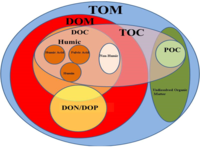
Photo from wikipedia
Abstract Increased nutrient inputs due to anthropogenic activity are expected to increase primary productivity across terrestrial ecosystems, but changes in allocation aboveground versus belowground with nutrient addition have different implications… Click to show full abstract
Abstract Increased nutrient inputs due to anthropogenic activity are expected to increase primary productivity across terrestrial ecosystems, but changes in allocation aboveground versus belowground with nutrient addition have different implications for soil carbon (C) storage. Thus, given that roots are major contributors to soil C storage, understanding belowground net primary productivity (BNPP) and biomass responses to changes in nutrient availability is essential to predicting carbon–climate feedbacks in the context of interacting global environmental changes. To address this knowledge gap, we tested whether a decade of nitrogen (N) and phosphorus (P) fertilization consistently influenced aboveground and belowground biomass and productivity at nine grassland sites spanning a wide range of climatic and edaphic conditions in the continental United States. Fertilization effects were strong aboveground, with both N and P addition stimulating aboveground biomass at nearly all sites (by 30% and 36%, respectively, on average). P addition consistently increased root production (by 15% on average), whereas other belowground responses to fertilization were more variable, ranging from positive to negative across sites. Site‐specific responses to P were not predicted by the measured covariates. Atmospheric N deposition mediated the effect of N fertilization on root biomass and turnover. Specifically, atmospheric N deposition was positively correlated with root turnover rates, and this relationship was amplified with N addition. Nitrogen addition increased root biomass at sites with low N deposition but decreased it at sites with high N deposition. Overall, these results suggest that the effects of nutrient supply on belowground plant properties are context dependent, particularly with regard to background N supply rates, demonstrating that site conditions must be considered when predicting how grassland ecosystems will respond to increased nutrient loading from anthropogenic activity.
Journal Title: Ecology
Year Published: 2022
Link to full text (if available)
Share on Social Media: Sign Up to like & get
recommendations!